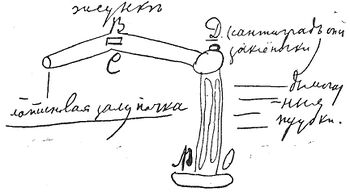Letter 2804
| Date | 30 October/11 November 1885 |
|---|---|
| Addressed to | Nikolay Tchaikovsky |
| Where written | Kamenka |
| Language | Russian |
| Autograph Location | Saint Petersburg (Russia): National Library of Russia (ф. 834, ед. хр. 37, л. 13–14) |
| Publication | П. И. Чайковский. Полное собрание сочинений, том XIII (1971), p. 155–156 |
Text and Translation
| Russian text (original) |
English translation By Julia Laukhina |
30 окт[ября] 1885 Кикикири – какакура!
Твоё официальное письмо получил и твоими почтительными выражениями, твоим просительным тоном остался доволен. А. Н. Островскому написал сейчас же, хотя как-то и странно было в письме от музыканта к драматургу писать о министерстве государственных имуществ. Однако ж написал и послал. Посылку получил, и вчера с помощью Коли Корсакова всё вынули и нашли в целости. Мне прибор очень нравится, но Анна Мекк и другие все страшно раскритиковали. Бог с ними. Благодарю тебя за совет «Черевичек». Твоя поправка будет, конечно, принята [к] сведению. Да! я и забыл. На днях, гуляя, я сделал открытие насчет механизма в локомотиве и спешу сообщить его тебе. По-моему, хотел не так до сих пор устраивался, и по-моему дымогарную трубу А никоим образом нельзя смешивать с шатуном третьей верхней заклепочки в кривошипной горизонтальности его. Ты сейчас это уви[дишь на] рисунке. Итак: пупковидный поршень ABC следует непременно так анализировать, чтобы дымогаряости вышло не N + p : ABC √1000
Я предлагаю поршенёк АВС назвать (по сходству с строением человеческого пальца) подвижным суставом, или дракцией. Целую тебя, П. Чайковский Поцелуй у Оли подвижный суставчик на каждом пальце руки. |
30 October 1885 Kikikiri – kakakura!
I received your official letter [1] and was satisfied with your expressions of respect and your supplicatory tone. I wrote to A. N. Ostrovsky forthwith, although it was somewhat strange for a musician to write a letter to a playwright about Ministry of State property. However, it's been written and sent [2]. The parcel came, and yesterday, with Kolya Korsakov's help, it was all unpacked and found to be intact [3]. I like the instrument very much, but Anna Meck and others criticized everything terribly. God be with them. Thank you for the "Cherevichki" advice. Your correction will, of course, be taken into consideration [4]. Oh yes, I forgot! The other day, while out for a stroll, I made a breakthrough concerning the mechanism in a locomotive, and I'm hastening to inform you about it. In my opinion, you don't want to keep doing it the same way, and I think that smoke stack A should not be connected at all to the connecting rod of the third upper rivet in its horizontal crank position. You can see it now in the drawing. Thus: the navel-shaped piston ABC should certainly be redesigned in such a way that no smoke comes out N + p : ABC √1000
I suggest that the ABC piston be called (due to its similarity to the structure of a human finger) a movable joint, or knuckle. I kiss you, P. Tchaikovsky Kiss every movable joint on each finger of Olya's hand. |
Notes and References
- ↑ Letter from Nikolay Tchaikovsky to the composer dated 21 October/3 November 1885.
- ↑ See Letter 2802 to Aleksandr Ostrovsky, 30 October/11 November 1885.
- ↑ Tchaikovsky is referring here to a silver wedding present bought by the Tchaikovsky brothers for their sister Aleksandra and her husband Lev Davydov.
- ↑ Nikolay, a railway engineer with little knowledge of music, had joked in another letter, dated 25 October/6 November 1885, that "It's a shame I wasn't able to warn you in time that Vakula's final aria [in the opera Cherevichki], together with the flat-contrapuntal range that follows, ought to have been written with a prolonged dissonance for a more realistic tune". The remaining text of the present letter is the composer's humorous riposte in the same vein.

